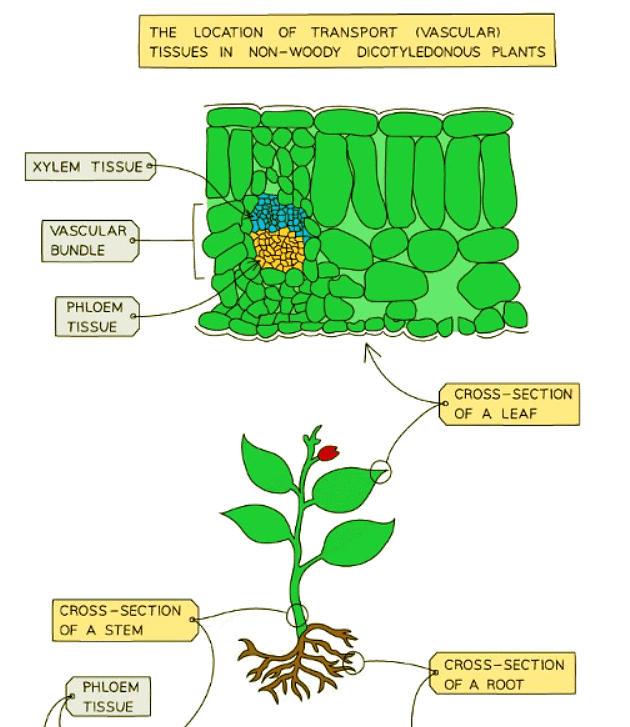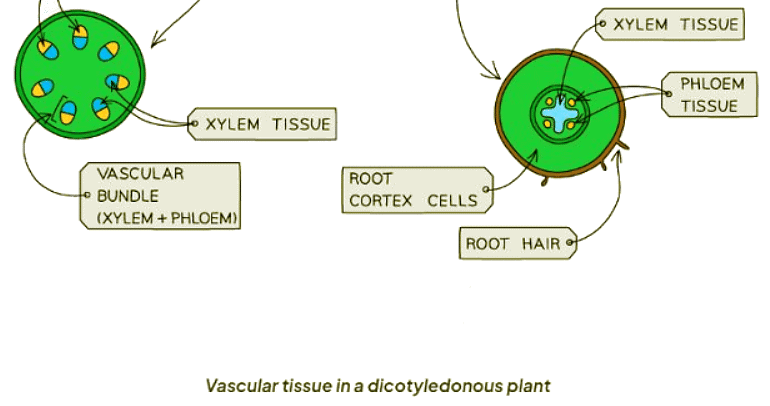Class 10 Exam > Class 10 Notes > Biology for GCSE/IGCSE > Xylem and phloem
Xylem and phloem | Biology for GCSE/IGCSE - Class 10 PDF Download
The Xylem & Phloem
- Plants have two types of transport vessels:
- Xylem vessels: responsible for transporting water and minerals from the roots to the stem and leaves.
- Phloem vessels: transport food materials like sucrose and amino acids from the photosynthesizing leaves to non-photosynthesizing areas in the roots and stem.
- These vessels are organized in groups known as vascular bundles, present throughout the root, stem, and leaves.


Adaptations of Xylem Vessels: Extended

- Function: Xylem vessels serve as the transport tissue responsible for conveying water and essential nutrients throughout the plant.
- Adaptations: These adaptations enhance the efficiency and structural integrity of xylem vessels:
- Xylem cells are interconnected end to end without the presence of cross walls, creating a continuous tube structure. This seamless arrangement aids in the uninterrupted flow of water from roots to leaves.
- The cells comprising xylem vessels are predominantly devoid of living contents, ensuring unimpeded water movement through them.
- The outer walls of xylem cells are reinforced with lignin, a strengthening compound that fortifies the tubes, providing structural support to the plant.
These adaptations collectively enable xylem vessels to efficiently transport water and maintain the structural stability of plants.
Question for Xylem and phloemTry yourself: What is the function of xylem vessels in plants?View Solution
The document Xylem and phloem | Biology for GCSE/IGCSE - Class 10 is a part of the Class 10 Course Biology for GCSE/IGCSE.
All you need of Class 10 at this link: Class 10
|
101 videos|193 docs|33 tests
|
FAQs on Xylem and phloem - Biology for GCSE/IGCSE - Class 10
| 1. What are the main functions of xylem and phloem in plants? |  |
Ans. Xylem is responsible for transporting water and minerals from the roots to the rest of the plant, while phloem transports sugars produced during photosynthesis to different parts of the plant.
| 2. How do xylem vessels differ from phloem vessels in terms of structure and function? |  |
Ans. Xylem vessels are made up of dead cells and are responsible for water transport, while phloem vessels are made up of living cells and transport sugars.
| 3. What are some adaptations of xylem vessels that allow for efficient water transport in plants? |  |
Ans. Xylem vessels have a tubular shape with reinforced cell walls to prevent collapse, as well as pits in the cell walls to allow for lateral water movement.
| 4. How do plants maintain the flow of water and nutrients in xylem and phloem vessels against gravity? |  |
Ans. Plants use transpiration and the cohesion-tension theory to create a negative pressure that pulls water up the xylem vessels, while phloem transport is aided by the pressure flow hypothesis.
| 5. How do xylem and phloem contribute to the overall growth and development of plants? |  |
Ans. Xylem and phloem play crucial roles in providing water, nutrients, and sugars to different parts of the plant, supporting growth, and aiding in processes like photosynthesis and respiration.
Related Searches
















